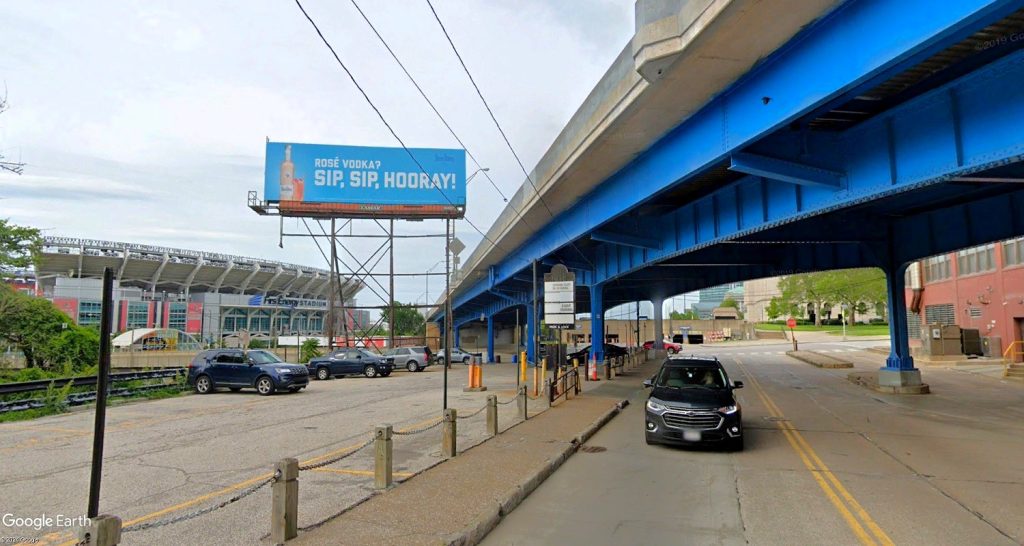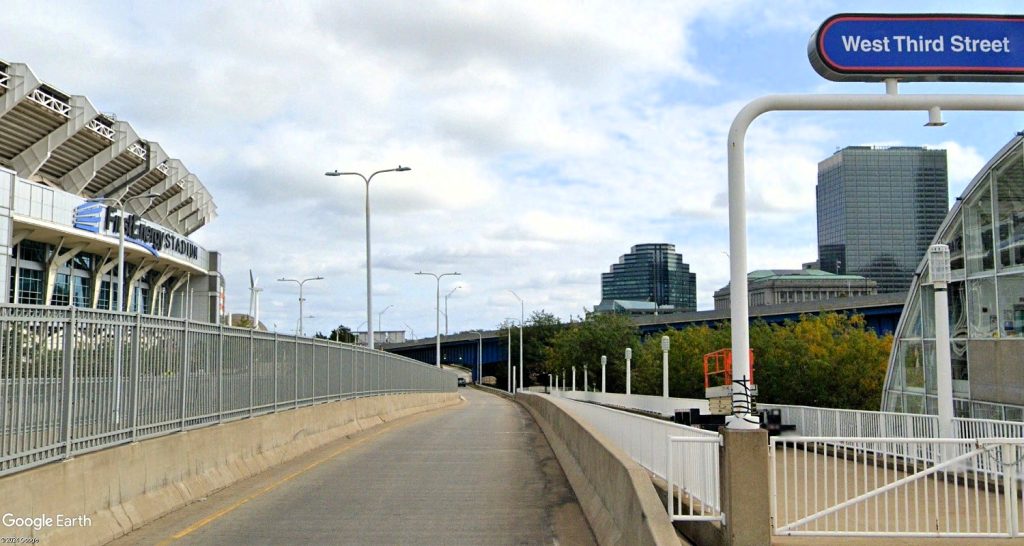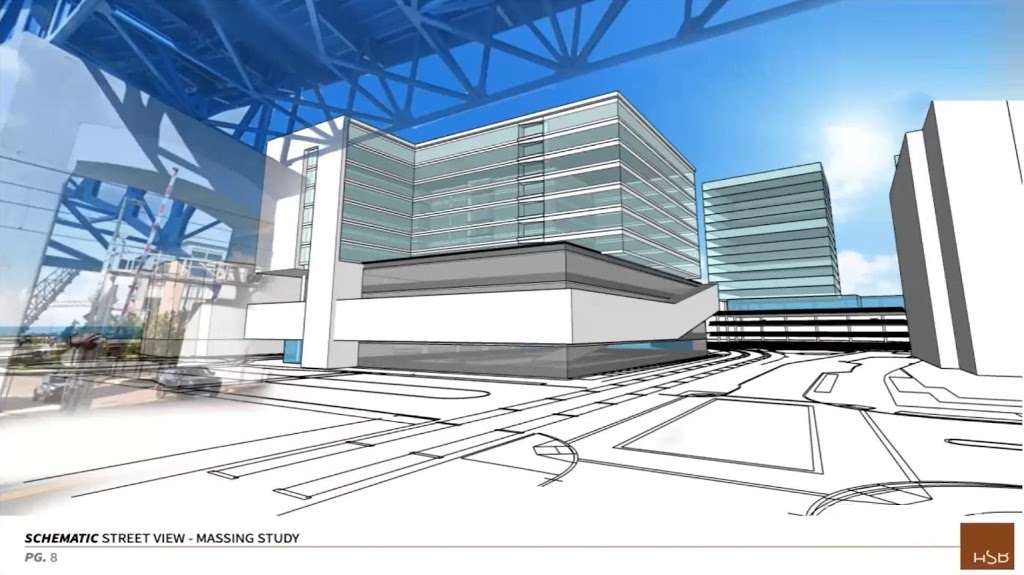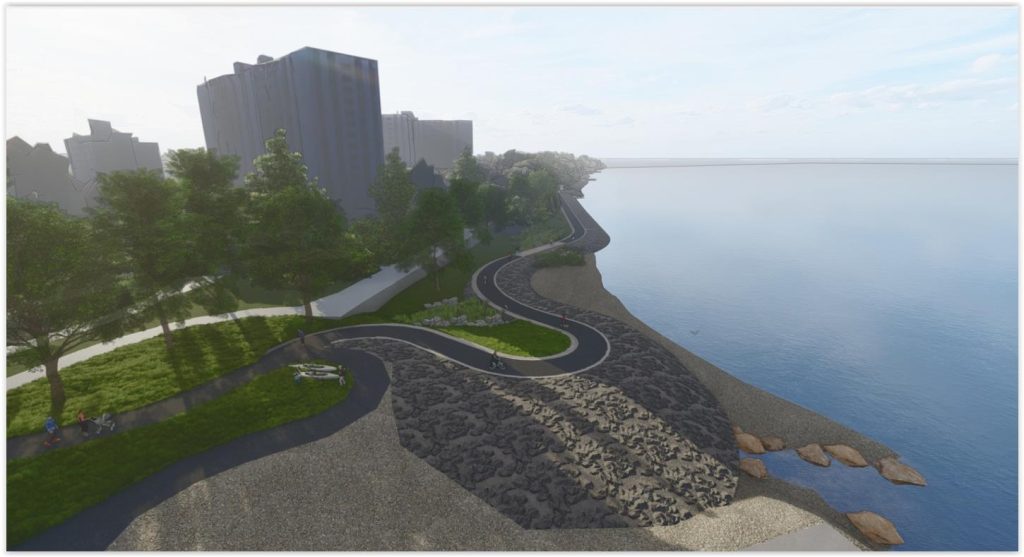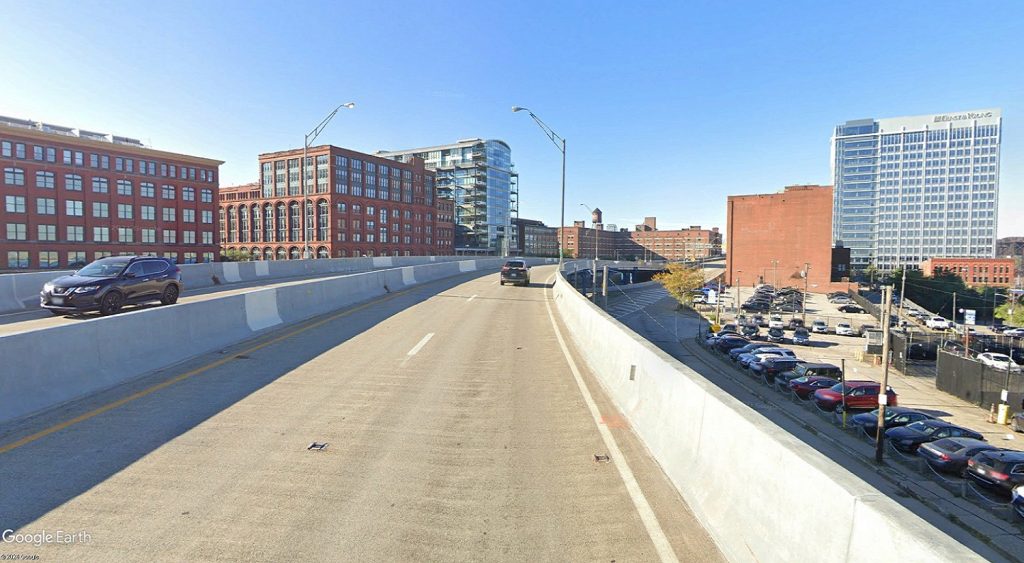
This elevated section of the Shoreway highway through Downtown Cleveland may soon be a memory. Its removal is key to achieving other parts of the city lakefront redevelopment, and will be funded in part by a $60 million grant from the U.S. Department of Transportation won today by the city of Cleveland (Google). CLICK IMAGES TO ENLARGE THEM.
Shoreway obstructs lakefront revitalization

Although it’s not the full $260 million federal grant that city of Cleveland officials had hoped to get for its lakefront vision, the $59.7 million it won today from U.S. Department of Transportation will knock down the first lakefront domino. Once knocked down, other aspects in the city’s plans can be funded and built.
That domino is the partial reconfiguration of the 85-year-old Shoreway, also known as State Route 2, into a pedestrian-friendly boulevard. Much of this highway is elevated through Downtown Cleveland, then drops below East 9th Street and has short-weave ramps between East 9th and West 3rd streets that cause traffic accidents and traffic congestion.
Reconfiguring the roadway will also get it out of the way of the city’s proposed North Coast Connector — a $230 million land bridge over the lakefront railroad tracks and Shoreway that was not funded today despite the city requesting it. City officials said they will continue to seek funding for this infrastructure which has attracted more than $20 million from other sources so far.
The North Coast Connector project is part of Mayor Justin Bibb’s Shore-to-Core-to-Shore vision to provide safe and equitable connectivity between downtown Cleveland and the waterfront for all users and modes of transportation and enable economic redevelopment and revitalization along the lakefront.
“We are thrilled to receive this significant investment from the INFRA program for the North Coast Connector project,” Bibb said in a written statement. “This grant will allow us to reimagine our waterfront access, transform outdated infrastructure, and build a safer, more vibrant connection between our residents, the lakefront, and the Port of Cleveland. This is a crucial step forward in making Cleveland a more connected and accessible city.”
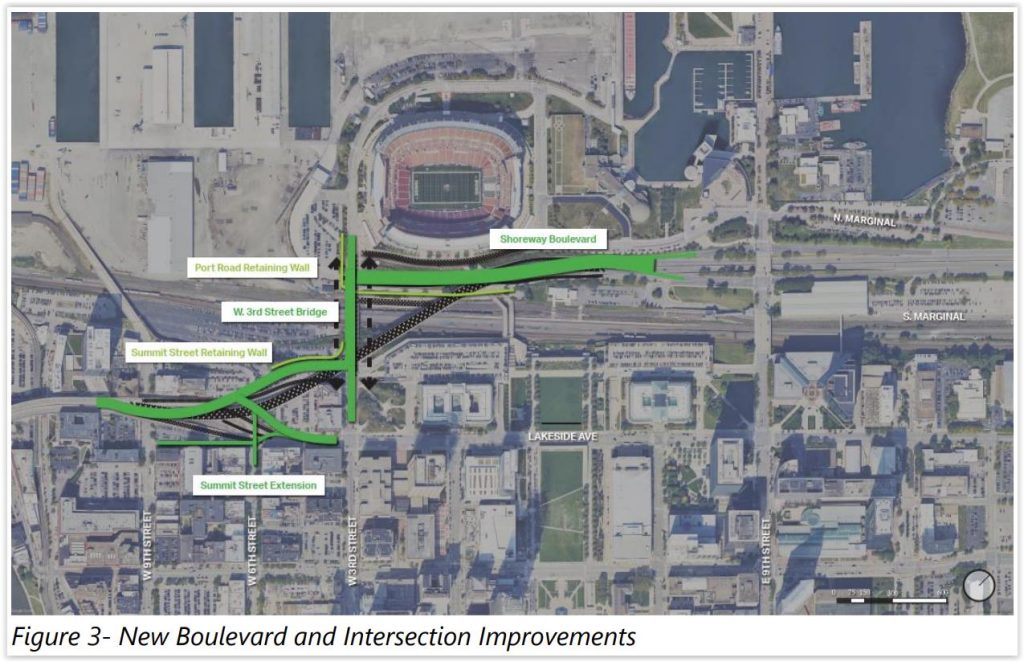
This map shows how the Shoreway will be partially reconfigured. Additional funds will be sought to reconfigure the Shoreway as a boulevard farther east to its interchange with Interstate 90. Future work includes an at-grade intersection with East 9th Street and extending East 18th Street north to intersect with the Shoreway boulevard (City of Cleveland).
The first phase of the city’s lakefront vision includes demolition of the Main Avenue Bridge span between West 9th Street and Erieside Avenue. It will be replaced by the construction of a widened pedestrian and bike-friendly West 3rd Bridge with a new intersection, and pre-construction and construction of a new Shoreway Boulevard segment from West 3rd to the East 9th ramps.
The project is estimated to break ground in 2027.
“I also extend my heartfelt gratitude to our dedicated congressional delegation, particularly U.S. Senator Sherrod Brown and Congresswoman Shontel Brown, for their unwavering support and advocacy in securing this grant for our city.” Bibb added. “Their commitment to improving our roads, bridges, and public facilities is a testament to their leadership.”
“This investment unlocks an exciting new future for Cleveland’s lakefront and downtown,” said Senator Brown. “The Cleveland community and our visitors will have new access to Lake Erie, our greatest natural resource, and a better transportation network that will drive growth. I want to thank Mayor Bibb, County Executive Ronayne, and Cleveland’s business community who all worked with us to support this project that will be transformational for all of us who call Cleveland home.”
Their sentiments were echoed by Ward 3 Councilman Kerry McCormack whose ward includes downtown and the near-West Side. He also chairs council’s Transportation and Mobility Committee. The funding was awarded less than three weeks before the November election.
“Sherrod Brown comes through again for Ohio,” McCormack told NEOtrans. “This investment through the Bipartisan Infrastructure Plan is a giant leap in our efforts to open Cleveland’s lakefront to our people. A huge thank you’ to everyone involve in securing these critical dollars for the North Coast Connector.”
The grant award is part of a broader strategy to modernize Cleveland’s infrastructure, create pedestrian- and bike-friendly spaces, and improve the city’s connection to its waterfront, supporting long-term goals of enhancing safety, mobility, and economic opportunities.
A portion of a reconfigured port access road also was funded. Not yet funded is reconfiguring the Shorweway into a boulevard farther east to its interchange with Interstate 90. That includes converting the Shoreway’s interchange with East 9th into an at-grade intersection and extending East 18th Street north to intersect with the boulevard.
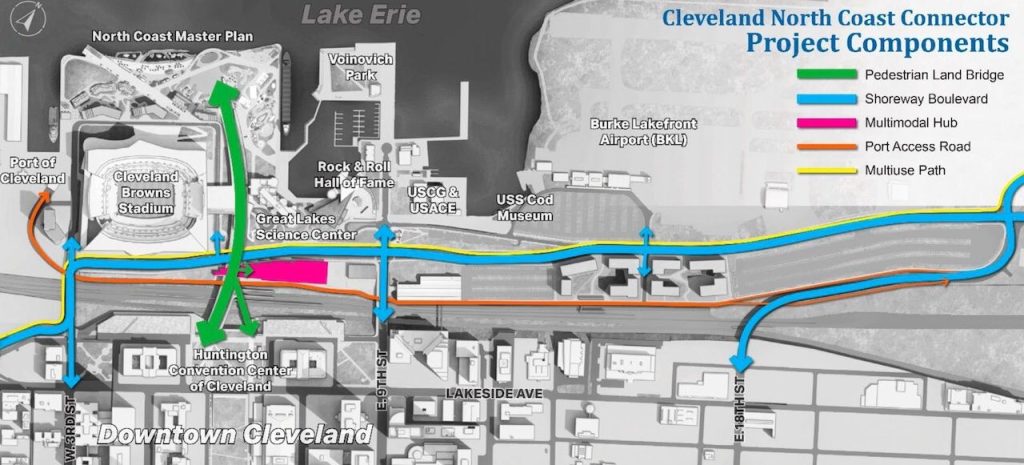
This diagram shows all of the planned components to achieve the city’s proposed North Coast Connector and lakefront vision. That includes an at-grade intersection with East 9th Street, just east of the planned multimodal transportation hub, and the S-curved East 18th Street extension at right (City of Cleveland).
Reconfiguring the port access road means having to demolish the Greater Cleveland Regional Transit Authority’s (GCRTA) West 3rd-Browns Stadium station on the light-rail Waterfront Line, according to the city. Senator Brown said the grant would also fund a proposed multimodal transportation hub that would combine the Waterfront Line’s West 3rd and East 9th stations into a single facility with Amtrak’s nightly passenger services.
“The project’s construction of a new multimodal Amtrak station will also help prepare Cleveland for the expansion of Amtrak service under development,” Brown said. “Last December, Brown announced that two routes serving Cleveland were selected as priorities for Amtrak expansion: Cleveland-Columbus-Dayton-Cincinnati, the 3C+D corridor, and the Cleveland-Toledo-Detroit corridor.”
Cuyahoga County Executive Chris Ronayne also hailed the grant award. He was the city’s planning director for then-Mayor Jane Campbell in 2004 when Cleveland advanced one of its most comprehensive lakefront plans in its history. But Campbell lost her reelection bid the next year to Frank Jackson who didn’t prioritize lakefront improvements during his 16 years in office.
“The city of Cleveland’s Lakefront Plan just moved from vision to reality,” Ronayne told NEOtrans today. “$60 Million from the Bipartisan Infrastructure Bill will transform the Cleveland harbor front. Thanks to Senator Sherrod Brown and Congresswoman Shontel Brown for this enormous support. We now have momentum to implement a truly inspiring civic vision.”
“The grant is an important first piece of the funding puzzle for the harbor development plan,” said Dick Clough, executive board chair of the nonprofit lakefront advocacy group Green Ribbon Coalition. “It is gratifying to witness concrete steps by the City and lakefront stakeholders to ‘finally’ achieve an exciting vision for the lakefront. Keep the pedal to the metal.”
The Ohio Department of Transportation (ODOT) supports a reconfigured Shoreway — Cleveland’s oldest freeway. Dating from the late-1930s, it doesn’t meet modern highway design and safety standards including entrance and exit ramps spaced too closely together, a lack of breakdown lanes on both sides of the roadway and other shortcomings.
There isn’t enough room downtown to address those shortcomings with a modern highway without reducing access points to downtown streets. So a boulevard approach was favored by ODOT, according to a letter written May 6 by then-ODOT Director Jack Marchbanks.
“The North Coast Connector is critical, enabling infrastructure that will link Downtown Cleveland’s business district with its lakefront,” Marchbanks wrote. “It will mitigate or eliminate the barriers to the lake and improve regional transportation infrastructure through the construction of a 120-foot-wide land bridge, removal of substandard ramps, and the major reconfiguration of a nearly two-mile segment of freeway into a modern, safe, and efficient multimodal boulevard.”

This map shows what is to demolished and removed. That includes the Shoreway between West 9th Street and East 9th Street, the Shoreway bridge between them, a West 3rd Street bridge over the lakefront railroad tracks that’s to be replaced, and the Greater Cleveland Regional Transit Authority Waterfront Line station that would be consolidated with East 9th’s station in a new multimodal hub (City of Cleveland).
END


